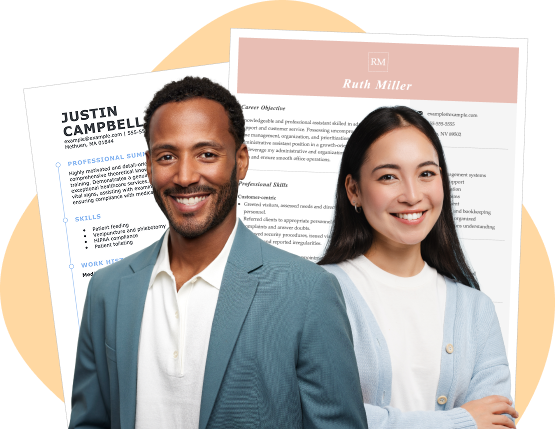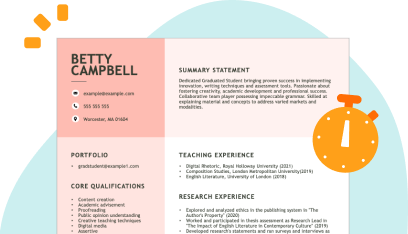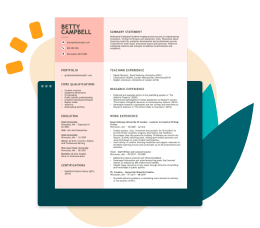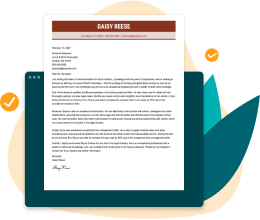Cornerstone
Modern Resume Templates
A well-designed professional resume template doesn’t have to be boring. Our modern resume templates, designed by professionals, allow you to have a resume that matches your sleek aesthetic while staying true to resume template quality standards and requirements. Once you’ve picked a resume template, the actual task begins: filling it in with your most job-relevant professional qualifications. Below, you’ll find a detailed guide on how to make the most of each resume section.
What Is a Modern Resume Template?
Our modern resume templates boast contemporary and refined design elements like clean lines, colored backgrounds and multi-column layouts, that make your resume dynamic and convey that you are up-to-date with current trends. These editable and downloadable resume templates are beneficial for roles in creative industries and forward-thinking companies. With these resume templates, you’ll get access to Resume Builder, featuring expert-written content suggestions you can copy and paste onto your resume.
Is a Modern Resume Template Right for You?
To determine whether a modern resume template is appropriate in your case, ask yourself the following questions:
Are you applying for a forward-thinking company?
Choose a resume design that suits your field. With its sleek design and formatting, a modern resume template is appropriate for cutting-edge industries like fintech, marketing or sales. Artistic roles like graphic design would benefit from a creative resume template, which allows more flexibility regarding colors and design elements.
Do you want an efficient and eye-catching resume template?
Our modern resume templates are characterized by their practical layout and dynamic design style. This powerful combination is crucial for highly-accomplished job seekers who want to write a resume with as much relevant information as possible without compromising streamlined organization.
Will this resume template pass an ATS?
Our modern resume templates are crafted to navigate applicant tracking systems (ATS) successfully. Our professional templates ensure ATS compliance by avoiding images and complex designs that could confuse the software.
Our simple resume templates are another ATS-friendly option for applicants with a minimal style. If you’re in an industry with a more formal culture, such as law or finance, our traditional templates are ideal.
If you’ve decided on a modern resume template, you can jump straight to our Resume Builder for a personalized touch. You’ll create a polished resume in just minutes with intuitive design tools and content suggestions from Certified Professional Resume Writers (CPRW).
Introduce Yourself With a Summary Statement
Start filling in your modern resume template with a compelling resume summary introducing yourself to potential employers. In two to four sentences, summarize critical aspects of your career that demonstrate you’re the ideal candidate for the job.
As you work on this section, keep these points in mind:
- Share crucial job requirements like your academic background or years of experience.
- List one to three of your crucial skills to succeed in the role.
- Include a unique achievement, certification or qualification that can set you apart from other candidates.
To help you write your resume summary, check out these two examples:
Paragraph style:
“Accomplished brand manager with 5+ years of experience in developing data-driven strategies that drive growth in brand engagement through targeted digital campaigns. Expertise in SEO, content strategy and influencer marketing, with a strong focus on consumer insights and market segmentation. Successfully led the rebranding of a major product line, resulting in 16% increase in market share. Skilled in managing cross-functional teams and optimizing multi-channel marketing efforts to build strong, competitive brand identities.”
List style:
- Over five years of experience as brand manager, specializing in data-driven strategies to enhance brand visibility and engagement.
- Increased brand engagement by 30% through targeted digital marketing and innovative content strategies.
- Proficient in SEO, market segmentation, consumer insights and influencer marketing to optimize campaigns.
- Led successful rebranding project that boosted market share by 16%.
Carefully Curate Your Skills Section
As you navigate your modern resume template, don’t underestimate the importance of your skills section.
You should at least include six to eight of your best skills, ensuring they relate to the job’s requirements.
A balanced mix of hard skills and soft skills is ideal for showing recruiters that you’re well-rounded with technical knowledge and interpersonal abilities.
For an impactful skills section, follow these tips:
- Use the job advertisement to identify high-priority skills to include in your resume.
- Once you’ve included those skills in your skills section, don’t repeat them across other resume sections.
- Choose the most job-relevant skills and edit this section for each job application.
Here are some of the most in-demand skills you can add to your modern resume template:
- Data analysis
- Cloud computing
- Artificial intelligence
- Cultural competency
- Leadership
- Cybersecurity
- Adaptability
- User experience (UX) design
- Critical thinking
Describe Your Work Experience
The work experience is the most important section you’ll have to write in your modern resume template. Beyond wanting to see a list of your previous roles, recruiters expect to learn what you accomplished.
For a complete work experience section, do the following:
- List your past roles in reverse-chronological order.
- Share your official job title, the employer’s name, work location and employment dates.
- Include at least three bullet points describing unique achievements from each role.
- If your employment gap is longer than a few months, note it along with any education, seminars or projects you took on during that time.
Check out the following bullet point work experience descriptions for top jobs:
Data Scientist
- Analyzed large datasets using Python and SQL to identify trends, optimize business processes and improve decision-making.
- Developed predictive models using machine learning algorithms, improving forecast accuracy by 20% for customer churn and product demand.
- Collaborated with cross-functional teams to design and implement data-driven strategies that enhanced operational efficiency and drove actionable insights.
UX/UI Designer
- Designed intuitive user interfaces for web and mobile applications, improving user satisfaction and engagement.
- Conducted user research and usability testing, leading to 27% increase in user retention by addressing pain points and enhancing the user journey.
- Collaborated with product managers and developers to create wireframes, prototypes and final designs, ensuring seamless platform integration and functionality.
Cybersecurity Analyst
- Monitored and analyzed network traffic to identify potential security threats, reducing incident response time by 30%.
- Implemented security protocols and vulnerability assessments, strengthening system defenses and preventing unauthorized access.
- Conducted regular security audits and provided actionable recommendations to mitigate risks and ensure compliance with industry standards.
Showcase Your Education
To complete your resume, fill out the education section of your modern resume template with all the key education requirements for your job. This section will vary in length and detail depending on your role and education level. However, some details every education section should include are:
- A list of relevant degrees in reverse-chronological order.
- The name of the institution you attended and its location (city and state).
- Any relevant achievements like GPA, special coursework, projects and honors.
This is an example of a resume education section:
Bachelor of Science in Computer Science
University of California, Berkeley – Berkeley, CA
- Relevant Coursework: Cryptography, Distributed Systems, Blockchain Fundamentals, Smart Contracts Development, Data Structures & Algorithms.
- Capstone Project: Developed a decentralized application (DApp) on the Ethereum blockchain to facilitate peer-to-peer lending using Solidity and Web3.js.
Use Action Verbs in Your Resume
Recruiters often receive hundreds of applications for highly competitive jobs; therefore, an easily scannable resume is essential. If you aim to stand out, your modern resume template should be easy to skim while highlighting essential information. Using action verbs to start your bullet points immediately showcases your achievements and keeps your resume concise, avoiding unnecessary or “filler” text.
To help you visualize the impact of action verbs, check out the following examples:
- Led cross-functional team to develop and implement new CRM system, resulting in 29% increase in customer retention.
- Developed and executed digital marketing strategy that boosted website traffic by 40% within six months.
- Streamlined internal processes by automating data entry, reducing manual input errors by 15%.
- Optimized supply chain logistics, decreasing delivery times by 20% and improving customer satisfaction.
Add Numbers to Your Modern Resume
Today’s competitive market pushes applicants to find ways to make their resumes more impactful and effective. Using numbers — dollar amounts, percentages and metrics — is a great way to validate your accomplishments. You’ll immediately grab the recruiters’ interest if you can provide proof of your past successes with quantifiable achievements.
The difference between using numbers and not using them is evident when you compare the two side-by-side. Check out the following examples:
Without numbers
- Improved customer satisfaction by enhancing service protocols.
- Led team to launch new product successfully.
- Increased website traffic by optimizing SEO and content strategy.
With numbers
- Improved customer satisfaction by 20% through implementing new service protocols.
- Led team of eight to successfully launch new product, generating $500K in revenue within first quarter.
- Increased website traffic by 35% in six months by optimizing SEO and content strategy.
Users find our resume templates helpful
Ready to land the job?
Join 28M+ others who’ve built a resume that works.

Featured in:*

*The names and logos of the companies referred to in this page are all trademarks of their respective holders. Unless specifically stated otherwise, such references are not intended to imply any affiliation or association with LiveCareer.











